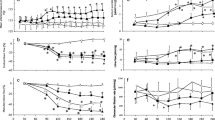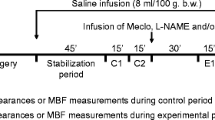Abstract
Angiotensin II was used as a probe to study the effect of changes in perfusate flow rate on the renal clearance parameters of chlorothiazide in the isolated perfused rat kidney. Perfusion studies were performed in five rats with no angiotensin II present in the perfusate and in five rats with a 1–4 ng/min infusion of angiotensin II into the perfusate. Angiotensin II had a dramatic effect on the renal hemodynamics, resulting in a 43% decrease in perfusate flow, a 16% decrease in glomerular filtration rate (GFR), and a 45% increase in filtration fraction. Values for the fractional excretion of glucose were low and consistent, with or without angiotensin II. Although the unbound fraction (fu)of chlorothiazide was unchanged between treatments, the renal (CLr)and the secretion clearances were reduced by about 50% in the presence of angiotensin II; the excretion ratio [ER=CLr/(fu·GFR)]was reduced by 38% with angiotensin II present in the perfusate. Analysis of the data was complicated by the presence of a capacity-limited transport for renal tubular secretion. Transport parameters (±SD) were obtained and the corrected intrinsic secretory clearance [(Vmax/GFR)/Km]of chlorothiazide was 123 ± 18 without angiotensin II vs. 72.8 ± 30.0 with angiotensin II. These results demonstrate that alterations in organ perfusion can significantly reduce the clearance parameters of chlorothiazide in the rat IPK. These flow-induced changes in intrinsic secretory transport may reflect perturbations other than that of perfusion flow rate alone.
Similar content being viewed by others
References
G. Levy. Effect of plasma protein binding on renal clearance of drugs.J. Pharm. Sci. 69:482–483 (1980).
S. Øie and L. Z. Benet. Altered drug disposition in disease states.Ann. Rep. Med. Chem. 15:277–287 (1980).
G. R. Wilkinson. Clearance approaches in pharmacology.Pharmacol. Rev. 39:1–47 (1987).
N. L. Benowitz. Effects of cardiac disease on pharmacokinetics: Pathophysiologic considerations. In L. Z. Benet, N. Massoud, and J. G. Gambertoglio (eds.),Pharmacokinetic Basis for Drug Treatment, Raven, New York, 1984, pp. 89–103.
L.-J. Lee and D. E. Smith. Effect of organ perfusion on renal drug transport: Application to furosemide in the isolated perfused rat kidney.Drug Metab. Dispos. 17:32–36 (1989).
C. A. M. van Ginneken and F. G. M. Russel. Saturable pharmacokinetics in the renal excretion of drugs.Clin. Pharmacokin. 16:38–54 (1989).
D. C. Brater and P. Chennavasin. Effects of renal disease: Pharmacokinetic considerations. In L. Z. Benet, N. Massoud, and J. G. Gambertoglio (eds.),Pharmacokinetic Basis for Drug Treatment, Raven, New York, 1984, pp. 119–147.
L. Z. Benet and L. B. Sheiner. Design and optimization of dosage regimens: Pharmacokinetic data. In A. G. Gilman, L. S. Goodman, T. W. Rall, and F. Murad (eds.),The Pharmacological Basis of Therapeutics, 7th ed., Macmillan, New York, 1985, p. 1678.
H. R. Brettell, J. K. Aikawa, and G. S. Gordon. Studies with chlorothiazide tagged with radioactive carbon (C14) in human beings.Arch. Intern. Med. 106:57–63 (1960).
L.-J. Lee, J. A. Cook, and D. E. Smith. Renal transport kinetics of chlorothiazide in the isolated perfused rat kidney.J. Pharmacol. Exp. Ther. 247:203–208 (1988).
F. H. Epstein, J. T. Brosnan, J. D. Tange, and B. D. Ross. Improved function with amino acids in the isolated perfused kidney.Am. J. Physiol. 243:F284-F292 (1982).
J. M. Nishiitsutsuji-Uwo, B. D. Ross, and H. A. Krebs. Metabolic activities of the isolated perfused rat kidney.Biochem. J. 103:852–862 (1967).
R. H. Bowman. The perfused rat kidney.Meth. Enzymol. 39:3–11 (1975).
W. W. Douglas. Polypeptides-angiotensin, plasma kinins, and others. In A. G. Gilman, L. S. Goodman, T. W. Rall, and F. Murad (eds.),The Pharmacological Basis of Therapeutics, 7th ed., Macmillan, New York, 1985, pp. 639–659.
A. C. Guyton. InTextbook of Medical Physiology, 5th ed., W. B. Saunders, Philadelphia, 1976, pp. 469–470.
E. K. Jackson, R. A. Branch, H. S. Margolius, and J. A. Oates. Physiological functions of the renal prostaglandin, renin, and kallikrein systems. In D. W. Seldin and G. Giebisch (eds.),The Kidney: Physiology and Pathophysiology, Vol. 1, Raven, New York, 1985, pp. 613–644.
E. T. Lin and L. Z. Benet. High pressure liquid chromatographic determination of chlorothiazide and hydrochlorothiazide in human serum and urine.APhA Acad. Pharm. Sci. 8(1):194 (1978).
T. N. Tozer, J. G. Gambertoglio, D. E. Furst, D. S. Avery, and N. H. G. Holford. Volume shifts and protein binding estimates using equilibrium dialysis: Application to prednisolone binding in humans.J. Pharm. Sci. 72:1442–1446 (1983).
MINSQ: Nonlinear parameter estimation and model development, MicroMath Scientific Software, Salt Lake City, UT, 1988.
F. Andreasen and E. Mikkelsen. Distribution, elimination and effect of furosemide in normal subjects and in patients with heart failure.Eur. J. Clin. Pharmacol. 12:15–22 (1977).
R. Babini and P. J. Du Souich. Furosemide pharmacodynamics: Effect of respiratory and acid-base disturbances.J. Pharmacol. Exp. Ther. 237:623–628 (1986).
D. C. Brater, R. Seiwell, S. Anderson, A. Burdette, G. J. Dehmer, and P. Chennavasin. Absorption and disposition of furosemide in congestive heart failure.Kidney Int. 22:171–176 (1982).
J. J. Cogan, M. H. Humphreys, C. J. Carlson, N. L. Benowitz, and E. Rapaport. Acute vasodilator therapy increases renal clearance of digoxin in patients with congestive heart failure. Circulation64:973–976 (1981).
C. A. Rodriguez and D. E. Smith. Influence of angiotensin II-induced alterations in renal flow on excretion of cefonicid in isolated perfused rat kidneys.Antimicrob. Agents Chemother. 36:616–619 (1992).
D. Alcorn, K. R. Emslie, B. D. Ross, G. B. Ryan, and J. D. Tange. Selective distal nephron damage during isolated kidney perfusion.Kidney Int. 19:638–647 (1981).
M. Brezis, S. Rosen, P. Silva, and F. H. Epstein. Selective vulnerability of the medullary thick ascending limb to anoxia in the isolated perfused rat kidney.J. Clin. Invest. 73:182–190 (1984).
M. Brezis, S. Rosen, P. Silva, and F. H. Epstein. Transport activity modifies thick ascending limb damage in the isolated perfused kidney.Kidney Int. 25:65–72 (1984).
W. Lieberthal, G. W. Stephens, E. F. Wolf, H. G. Rennke, M. L. Vasilevsky, C. R. Valeri, and N. G. Levinsky. Effect of erythrocytes on the function and morphology of the isolated perfused rat kidney.Renal Physiol. 10:14–24 (1987).
W. Lieberthal, M. L. Vasilevsky, C. R. Valeri, and N. G. Levinsky. Interactions between ADH and prostaglandins in isolated erythrocyte-perfused rat kidney.Am. J. Physiol. 252:F331-F337 (1987).
I. A. M. De Lannoy, R. Nespeca, and K. S. Pang. Renal handling of enalapril and enalaprilat: Studies in the isolated red blood cell-perfused rat kidney.J. Pharmacol. Exp. Ther. 251:1211–1222 (1989).
H. R. Jacobson and J. P. Kokko. Diuretics: Sites and mechanisms of action.Ann. Rev. Pharmacol. Toxicol. 16:201–214 (1976).
T. Maack. Physiological evaluation of the isolated perfused rat kidney.Am. J. Physiol. 238:F71-F78 (1980).
Author information
Authors and Affiliations
Additional information
This work was supported in part by the National Institutes of Health grant GM 35498. At the time of this study, S. Guillard was a pharmacy student of Xavier University of Louisiana participating in our Summer Undergraduate Research Program. During the course of this work, C. A. Rodriguez was supported by a Rackham Minority Merit Fellowship from The University of Michigan.
Rights and permissions
About this article
Cite this article
Smith, D.E., Guillard, S. & Rodriguez, C.A. Effect of angiotensin II-induced changes in perfusion flow rate on chlorothiazide transport in the isolated perfused rat kidney. Journal of Pharmacokinetics and Biopharmaceutics 20, 195–207 (1992). https://doi.org/10.1007/BF01071001
Received:
Revised:
Published:
Issue Date:
DOI: https://doi.org/10.1007/BF01071001




